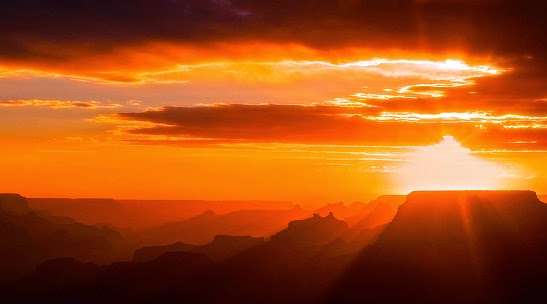Visualizing the Ragas
Raag Madhuvanti
I visualize raga Madhuvanti with the yellow majestic sun-set, which somewhat darkens the environment. An insipid but beautiful evening full of balmy environment...as if, however all the flora has been darkened because of the sun's radiance, but still that radiance merge into soul's flame end up giving a pacifistic feel.
Madhuvanti, being a karuna-rasa raga, is one of my favorite ragas for the reason it makes my perception a little confused. I cannot decide whether to take it more towards a happy raga or sad ones. I enjoy singing Madhuvanti and listening to it for hours though, I am never serious singing it. Ideally, its taken as a serious raga as it consists of the third flat and forth sharp which makes it sound more serene and tender. Notes go like...N-S-g-m-P-N-SA making gandhar flat komal and madhyam sharp teevr. I wont consider that emotional or over-tensed but it surely incorporates serenity and subtlity which gives me a balanced feel. All in all, one would not be overwhelmed or ecstatic listening or singing Madhuvanti, but would obviously be more towards cool, composed, balanced. And that's what I like about this raga.
Western Version: VII(L) I IIIb IV# V VII Oct.... Oct VII VI V IV# IIIb II I
Phrases goes on : ni sa ga ma pa, pa ma ga, ga re sa, ga ma pa ni dh pa, pa dha ma pa ma ga, ma ga re sa... (going higher) ga ma pa ni SA, ni S ni dha pa, dha ma pa, ma ga,
Raag Maru-Bihag
Another beautiful Raga which is more playful and feminine, Feminine because it suits women voice as it is full of eroticism. In Hindi, we call shringarik rasa pradhan. Ancient-Indian author Bharata Muni states about eight most essential mental states or moods or rasa and their expressions - shringaar (love), hasya (mirth), raudra (anger), karuna (grief), vibhatsa (excitement or energy), bhayanak (fear), Veer (bravery or heroism), adbhut rasa depicting astonishment. Therefore, these eight moods play an important role in classifying the ragas according to their aesthetical approach.
Raga Maru-Bihag, according to me, is more like cheerful and frisky. I would like to sing it when I feel a good energy within me... or when I feel one of my chakra-functioning is more active...or even when I am in a dance mode. But that's only my perception. Ideally, this raga is taken as a romantic or exotic one. As I specified it's a shringaarik raga more within the panorama of beloved's or charm, but whimsical. It certainly does not incorporates sad love.
Western version: VII(L) I III IV# V VII OCT..... Oct VII VI V IV# III II I
Note-series go like: Ni sa ga ma (teevr) pa ni SA -Sa ni dha pa ma ga re sa... as in IVth is sharpened. Similar to Bihag but ma ga re sa is pretty creative while descending.
Raga Abhogi
Abhogi injects a gentle and clear-cut tendency within me...It is a kind of simple raga just having five swaras with gandhar komal (flat), i.e. FLATTED IIIrd and omitting pancham (Vth) and nishaad (VIIth). Therefore, it comprises of I, II, II#(IIIb), IV, VI, these five notes. sing it often because I find it an easy and aesthical raga. According to Indian Rasa system of symbolizing aesthetics, I think it also covers the realm of shringaar rasa but not so romantic like maru bihag. Actually it gets more pleasing and captivating when gandhar becomes over-flat or a little more vibrated than normal flat G. In hindi its called andolit-komal-gandhaar.
I love the phrases like sa re ga, re ga ma ga re sa dh(lower) re sa.... sa re ga ma, ga ma dha SAAAA,
Saa dha ma ga re, re ga ma ga re sa.... sa re ga re ga ma ga ma dhaaaa.....dha ma ga , re ga ma ga re sa dh(L) re dha(L) sa...

Efficient method to combat dehydration quickly.
ReplyDeleteLiquid iv hydration in Menifee